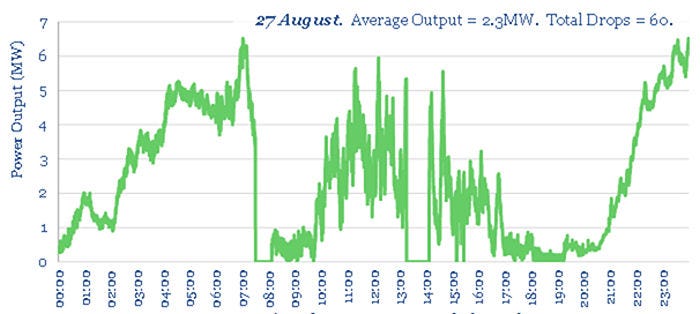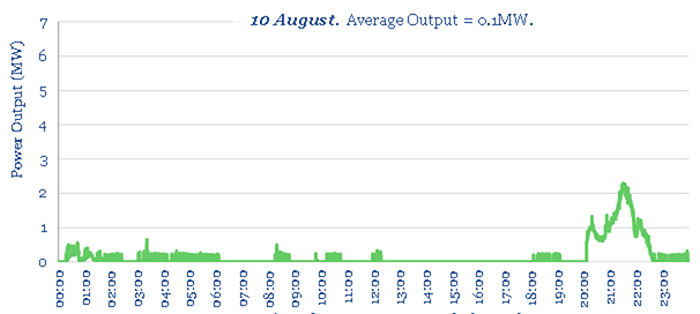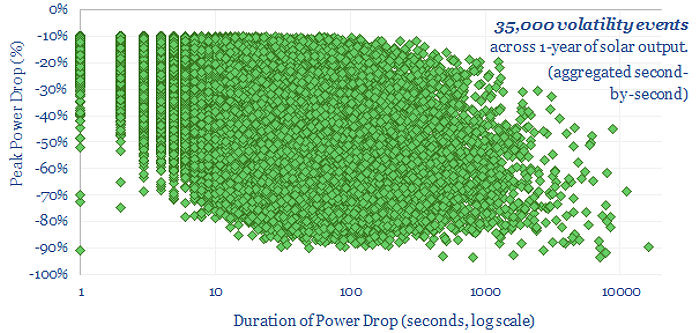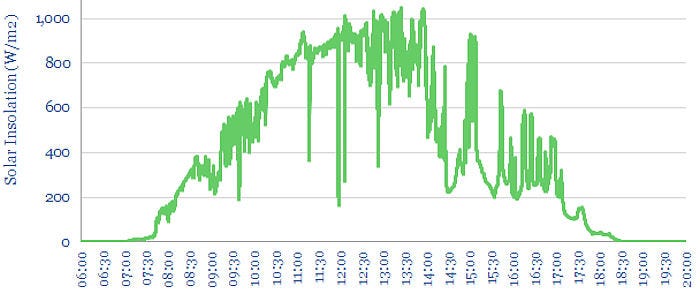Level Playing Field
Step One
Wind and solar generation are intermittent forms of renewable generation. Wind generation functions only when wind velocity is above a minimum threshold and below a maximum threshold. Solar functions only during the daytime, and then only when the sun shines. This wind velocity intermittency is reasonably predictable over the short term. The nighttime unavailability of solar is totally predictable and the sunshine intermittency is reasonably predictable over the short term.
However, these are not the only intermittency issues with wind and solar. There are also second-by-second volatility events which affect the output of wind and solar generators. The graphs below are taken from papers authored by Thunder Said Energy.
The graph below displays the short-term volatility of wind output from a 25 MW wind facility over a one-month period. During this month there were an average of 75 short-term volatility events per day during which power output dropped by more than 10% and as much as 100% for at least 1 second and fewer than 100,000 seconds (~28 hours). While every day and every month are unique, this monthly record displays a type of wind variability which is rarely discussed. This volatile wind facility output is fed to an electric grid which must match supply and demand for 60 cycles every second.
The next graph shows the variation of wind power output from the 25 MW wind facility over the course of a single day, during which maximum output was approximately 6.5 MW, or approximately 25% of rating plate capacity, and the average output was 2.3 MW, or approximately 10% of rating plate capacity.
The next graph shows the output of the 25 MW wind facility over a period of a single day during which maximum output was approximately 2.3 MW and the average output was 0.1 MW.
The graph below displays the short-term volatility of solar output over a period of 1 year. During this year there were an average of 96 volatility events per day during which power output dropped by more than 10% and as much as 95% for at least 1 second and fewer than approximately 13,000 seconds (~3.6 hours).
The final graph shows the variation in solar insolation on a single day. This is the type of intermittency which is generally discussed regarding solar energy. The times of day when measurable insolation becomes available and ceases to be available would change with latitude and with the seasons, as would the maximum daily insolation.
Currently, it is the responsibility of the grid operator to compensate for the volatility of wind and solar generation output. Typically, the grid operator is dealing with input to the grid from numerous wind facilities and/or solar fields, each of which is experiencing volatility to some degree. The volatility might be either synchronous or asynchronous at any given time. Smoothing this volatility imposes costs on the grid which result in increased electricity prices.
To level the playing field for the various sources of electric generation, the volatility of wind and solar output should be smoothed prior to output delivery to the grid. Smoothing could be accomplished with capacitors or batteries, or a combination of both. This will become increasingly important as the fraction of intermittent generation on the grid increases and the availability of dispatchable conventional generation to compensate for wind and solar volatility decreases. Of course, the maximum output of the wind and solar generation facilities would be reduced somewhat by the need to recharge capacitors or storage used to smooth the output volatility.





